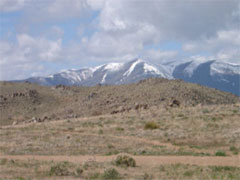Oil Exec Sequestration May Provide Answer to Global Warming
Reno, August 12, 2012 -- A controversial proposal released today may offer a simple, easily applied solution to the intractable issues of climate change and global warming.
 Oil industry executive sequestration test site
Oil industry executive sequestration test site
Developed by scientists at the Nevada-based Reno Institute for Climate Puzzlings, the suggestion urges the long-term "sequestration" of top carbon emitters—essentially, the burying of carbon emitters in extremely deep holes within the earth's crust where they can do no further harm to the atmosphere.
"It's brilliant in its simplicity, its application of currently available technologies, and its remarkable cheapness," Dr. Derek Derrick, spokesman for Climate Puzzlings, said during a press conference today announcing the proposal.
"Older suggestions involved the sequestration of carbon dioxide emissions, the number one greenhouse gas, themselves. However, the sheer quantity of these emissions made any kind of comprehensive sequestration program economy unviable, which is why it's been essentially dead in the water this past decade, while global temperatures continue to rise."
According to Dr. Derrick, nearly 11 quintillion tons of surplus carbon dioxide are emitted annually worldwide. Even best case scenarios developed by the American Petroleum Institute indicate full sequestration of these emissions would cost more than the gross national products of France, Canada, and Mexico combined. API repeatedly used these projections to strengthen the "status quo, no worries" policies practised last decade by the administration of former president George W. Bush.
"That's why we went looking for a more efficient solution," Dr. Derrick said. "When you're taking out a hornet's nest, you can ignore the drones. All you need to do is go for the queen. Within a day or two, boom, the nest is empty. Same thing here. We decided to skip the end user and aim straight for the middleman."
Dr. Derrick said the plan would require "the annual capture, collection and sequestration of specific carbon-based life forms, including between 200 and 500 oil industry executives, lobbyists and political hacks and cronies, in a 5000-foot deep chasm far below the earth's surface."
"The concept is similar to that of the tobacco industry," Dr. Derrick said. "People get addicted to tobacco, which kills consumers, so what do you do? You nail the tobacco companies. People everywhere are addicted to oil, which is killing our planet, so the same reasoning applies."
"Our analysts estimate the sequestration procedure should be quite simple to implement using either 'gloves-off' coercive methods of the kind advocated by former Vice President Cheney, or by simply placing common oil industry 'bait', such as hookers, bribes, kickbacks and malt whisky, down in the chasm. Most execs will simply follow their noses, then we seal the lid. After, of course, extracting the hookers."
Under a pilot sequestration project proposed by the Institute, industry leaders including the CEOs of ConocoPhillips, ExxonMobil, BP, ChevronTexaco and Shell would join top oil industry flacks including the aforementioned Dick Cheney, former president George W. Bush (currently chief press officer for ExxonMobil), Oklahoma senator James Inhofe, and other oil industry apologists and climate change deniers in a "comfortable, hermetically-sealed sequestration chamber" at the institute's test facility one mile below the surface of Carson City, Nevada.
"We'd make sure they were comfortable—inbound digital tv and newspapers, plenty of canned food, drink, and gentleman's periodicals," Dr. Derrick said, "but no outbound communications, of course. Once we've licked this climate change problem in, say, 150 years, we can think about going and digging them up again."
By Ion Zwitter, Avant News Editor
Related stories
- Godzilla-like creature ”natural phenomenon”, says TEPCO chairman
- Study Finds Less to be Less, Not More, Than More
- God Contrite About "Collateral Damage" in Huckabee Tornado Smite Attempt
- Wal-Mart Goes Green: The New Wal-Mart Employee Emissions Reduction Program
- Study Suggests Soul Sale Obesity Panacea
- California Scientists Map God Genome
- Texas Rings In New Clean Air Rules With Tire Fire
- Aliens Announce Completion of Human Observation and Research Program
- God Loses Dice
Copyright © 2005-2505 AvantNews.com. All rights reserved.
Avant News contains satire and other fictional material, provided for entertainment purposes only. Disclaimer. Syndicate. Privacy.











